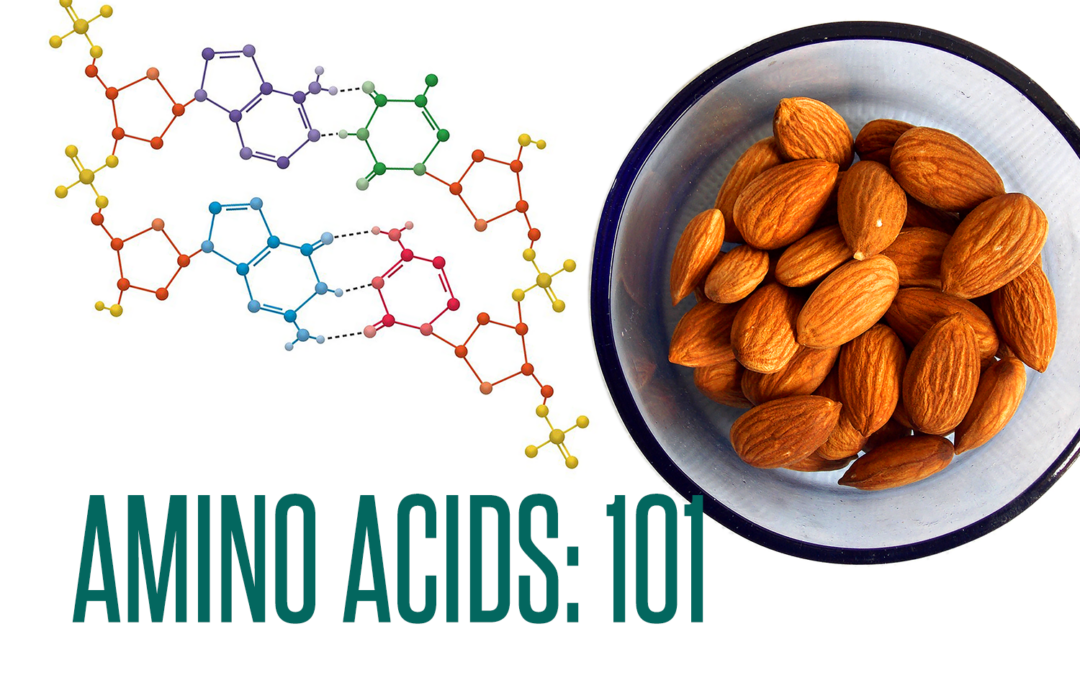Did you know that there are 20 different amino acids that are used by the human body to build proteins?
These molecules, often referred to as the “building blocks” of life, play a crucial role in various physiological processes. Beyond their structural function, amino acids are integral to cellular signaling, enzymatic activity, and metabolic regulation.
Exploring the biochemical intricacies of amino acids and their profound impact on human physiology and well-being is crucial for individuals navigating their wellness journey. Understanding how amino acids regulate metabolism, support muscle growth and repair, and optimize nutrition provides valuable insights for achieving holistic health goals.
JUMP TO…
Types of Amino Acids
Functions of Amino Acids: What do they do?
What happens if your body doesn’t have amino acids?
What diseases are caused by lack of amino acids?
Sources of Amino Acids
Foods Highest in Amino Acids
Taking Amino Acid Supplements
Amino Acids Supplements vs. Whole Protein Sources
Factors Affecting Amino Acid Absorption
Top Fruits & Vegetables That Provide Amino Acids
9 minute read
Types of Amino Acids
Amino acids are often categorized into three main types based on their chemical properties and role in protein synthesis: essential, non-essential, and conditionally essential amino acids.
Essential Amino Acids:
These are amino acids that the body cannot produce on its own and must be obtained through diet.

There are nine essential amino acids:
- histidine
- isoleucine
- leucine
- lysine
- methionine
- phenylalanine
- threonine
- tryptophan
- valine.
They play crucial roles in protein synthesis, muscle repair, immune function, and overall growth and development.
Non-Essential Amino Acids:
Non-essential amino acids are those that the body can synthesize on its own, so they do not need to be obtained directly from the diet.
There are eleven non-essential amino acids:
- alanine
- arginine
- asparagine
aspartic acid - cysteine
- glutamic acid
- glutamine
- glycine
- proline
- serine
- tyrosine
While they may not be required from dietary sources, they still contribute to various physiological functions, such as neurotransmitter synthesis, hormone regulation, and energy production.
Conditionally Essential Amino Acids:
Conditionally essential amino acids are typically non-essential, but under certain conditions, such as illness, stress, or during specific life stages like infancy or pregnancy, they may become essential because the body cannot produce them in sufficient quantities. Examples include arginine, cysteine, glycine, glutamine, proline, serine, and tyrosine.
Stressing the Importance of Essential Amino Acids:
While ensuring the body gets adequate levels of essential and non-essential amino acids, essential amino acids are vital for various physiological processes. They cannot be synthesized by the body and must be obtained from dietary sources. Ensuring an adequate intake of essential amino acids through a balanced diet is crucial for overall health and well-being, especially during periods of rapid growth and development.
Functions of Amino Acids: What do they do?

Amino acids serve as the building blocks of proteins, which are essential for the structure, function, and regulation of cells, tissues, and organs in the body. They are also involved in the synthesis of enzymes, hormones, neurotransmitters, and other bioactive molecules that regulate various physiological processes.
Role in Protein Synthesis:
- Amino acids are linked together through peptide bonds to form polypeptide chains, which fold into specific three-dimensional structures to create proteins.
- Protein synthesis occurs through the process of transcription and translation, where the genetic information encoded in DNA is transcribed into messenger RNA (mRNA) and then translated into a specific sequence of amino acids to form a protein.
Contribution to Various Bodily Functions:
- Muscle Repair: Essential amino acids play a crucial role in muscle protein synthesis, which is essential for muscle growth, repair, and maintenance.
- Hormone Regulation: Amino acids are involved in the synthesis of hormones and signaling molecules that regulate various physiological processes, including metabolism, growth, and reproduction.
- Immune Support: Amino acids are essential for the production of antibodies, cytokines, and other immune-related molecules that help the body defend against infections and diseases.
- Neurotransmitter Function: Certain amino acids, such as glutamate, glycine, and gamma-aminobutyric acid (GABA), serve as neurotransmitters in the brain, playing a role in synaptic transmission and neural signaling.
- Energy Metabolism: Amino acids can be metabolized for energy production during periods of fasting or low carbohydrate intake, serving as an alternative fuel source for the body.
What happens if your body doesn’t have amino acids?
If the body doesn’t have an adequate supply of amino acids, it can lead to various health issues and physiological dysfunctions. Here are some potential consequences:
- Protein Deficiency: Without amino acids, the body cannot synthesize proteins, which are essential for the structure, function, and regulation of cells, tissues, and organs. Protein deficiency can result in impaired growth and development, muscle wasting, weakened immune function, and impaired wound healing.
- Muscle Loss: Amino acids, particularly essential amino acids, are crucial for muscle protein synthesis. Inadequate intake of amino acids can lead to muscle loss, weakness, and decreased muscle function.
- Impaired Metabolic Function: Amino acids play a vital role in various metabolic pathways, including energy metabolism, nutrient transport, and the synthesis of enzymes and hormones. Without amino acids, metabolic processes may be disrupted, leading to imbalances in energy production, nutrient utilization, and hormone regulation.
- Reduced Immune Function: Amino acids are necessary for the production of antibodies, cytokines, and other immune-related molecules that help the body defend against infections and diseases. A deficiency in amino acids can weaken the immune system, making individuals more susceptible to infections and illnesses.
- Neurological Symptoms: Certain amino acids, such as neurotransmitter precursors, are essential for proper brain function and neurotransmitter synthesis. Amino acid deficiency may lead to neurological symptoms, including cognitive impairment, mood disorders, and disruptions in neural signaling.
What diseases are caused by lack of amino acids?
A lack of amino acids can lead to various health issues and contribute to the development of certain diseases such as…
Kwashiorkor and Marasmus
Severe protein-energy malnutrition, characterized by inadequate intake of protein and essential amino acids, can lead to conditions like kwashiorkor and marasmus. These conditions result in muscle wasting, stunted growth, weakened immune function, and other serious health complications.
Muscle Wasting Disorders
Conditions that impair protein synthesis or increase protein breakdown, such as cachexia, sarcopenia, and muscular dystrophy, can lead to muscle wasting and weakness. Inadequate intake of amino acids, particularly essential amino acids, can exacerbate these conditions and worsen muscle loss.
Neurological Disorders
Certain neurological disorders, such as phenylketonuria (PKU) and maple syrup urine disease (MSUD), are caused by genetic mutations that impair the body’s ability to metabolize specific amino acids. Without proper treatment and management, these conditions can lead to neurological symptoms, cognitive impairment, and developmental delays.
Immune Deficiencies
Amino acids are essential for the production of antibodies, cytokines, and other immune-related molecules that help the body defend against infections and diseases. A deficiency in amino acids can weaken the immune system and increase the risk of infections, autoimmune disorders, and other immune-related diseases.
Metabolic Disorders
Disorders of amino acid metabolism, such as phenylketonuria (PKU), maple syrup urine disease (MSUD), and homocystinuria, can lead to the accumulation of toxic metabolites and disruptions in metabolic pathways. These conditions can result in a range of health problems, including neurological symptoms, developmental delays, and organ damage.
Sources of Amino Acids
Obtaining amino acids through diet is essential for overall health and well-being. Protein-rich foods serve as primary sources, providing essential amino acids necessary for various physiological functions. Incorporating a diverse range of protein sources, including lean meats, fish, eggs, dairy products, legumes, and nuts, ensures optimal amino acid intake for supporting muscle growth, repair, and overall health.
Foods Highest in Amino Acids
Lean Meats: Beef, chicken breast, turkey, pork loin, and lamb are excellent sources of complete protein, containing all nine essential amino acids.
Fish: Salmon, tuna, trout, and other fatty fish are rich in protein and provide essential amino acids, particularly omega-3 fatty acids.
Eggs: Eggs are a complete protein source, containing all essential amino acids in optimal ratios. Both egg whites and yolks contribute to amino acid intake.
Dairy Products: Milk, cheese, yogurt, and cottage cheese are high in protein and provide essential amino acids, particularly lysine and leucine.
Legumes: Beans, lentils, chickpeas, and peas are plant-based sources of protein that contain various essential amino acids, particularly lysine.
Soy Products: Tofu, tempeh, and edamame are rich in protein and provide all essential amino acids, making them suitable options for vegetarians and vegans.
Quinoa: Quinoa is a pseudo-grain that is considered a complete protein source, containing all nine essential amino acids.
Nuts and Seeds: Almonds, peanuts, walnuts, pumpkin seeds, and chia seeds are high in protein and provide essential amino acids, particularly arginine and lysine.
Greek Yogurt: Greek yogurt is higher in protein compared to regular yogurt and contains all essential amino acids, making it a nutritious snack or ingredient in meals.
Spirulina: Spirulina is a type of blue-green algae that is rich in protein and provides all essential amino acids, making it a popular supplement for vegetarians and vegans.
Taking Amino Acid Supplements
Amino acid supplementation may be considered in certain circumstances, but it’s essential to understand the potential benefits and risks.
While supplements can provide concentrated doses of specific amino acids, they may not always be necessary, especially if a balanced diet rich in protein is maintained. It’s crucial to consult with a healthcare professional before starting any supplementation regimen to ensure safety and efficacy.
Who Should Not Take Amino Acids?
Certain individuals may not benefit from amino acid supplementation, including those with specific health conditions or who are taking certain medications. Conditions such as kidney disease or liver dysfunction may warrant caution, as excessive amino acid intake can exacerbate these conditions.
Potential Risks of Excess Amino Acid Consumption
Consuming too much amino acids, particularly through supplementation, can lead to several potential health risks and adverse effects:
Digestive Issues: Excessive amino acid intake can overwhelm the digestive system, leading to symptoms such as nausea, diarrhea, bloating, and abdominal discomfort.
Dehydration: Some amino acids, such as branched-chain amino acids (BCAAs), can increase water retention in the body. Consuming excessive amounts of BCAAs without adequate hydration can lead to dehydration and electrolyte imbalances.
Kidney Strain: The kidneys are responsible for filtering and excreting excess nitrogen and waste products from protein metabolism. Consuming too much protein or amino acids can put strain on the kidneys and may exacerbate pre-existing kidney conditions or increase the risk of kidney stones.
Imbalance of Neurotransmitters: Amino acids play a crucial role in neurotransmitter synthesis, and excessive intake of certain amino acids can disrupt the balance of neurotransmitters in the brain. This imbalance can affect mood, cognitive function, and behavior.
Metabolic Imbalances: Excessive amino acid intake can disrupt metabolic pathways and lead to imbalances in various metabolic processes. This can result in issues such as insulin resistance, dyslipidemia, and disruptions in energy metabolism.
Liver Dysfunction: The liver is responsible for metabolizing amino acids and converting them into other compounds. Consuming excessive amounts of amino acids can place a burden on the liver and may lead to liver dysfunction or damage over time.
Bone Health Issues: High protein intake, particularly from animal sources, has been associated with calcium loss from the bones and an increased risk of osteoporosis. Excessive amino acid intake may exacerbate this effect and negatively impact bone health.
Overall, while amino acids are essential for health, it’s crucial to consume them in moderation and obtain them primarily from dietary sources rather than relying heavily on supplements.
Amino Acids Supplements vs. Whole Protein Sources
Comparing amino acid supplements to whole protein sources involves weighing the benefits and drawbacks of each option. While amino acid supplements provide concentrated doses of specific amino acids, whole protein sources offer a broader spectrum of nutrients and bioactive compounds. The choice between supplements and whole foods depends on individual goals, preferences, and dietary patterns.
Side Effects of Amino Acid Supplementation
Common side effects of amino acid supplementation may include gastrointestinal discomfort, allergic reactions, or interactions with medications. Monitoring for adverse reactions and consulting with a healthcare professional can help manage potential risks and ensure safe supplementation practices.

